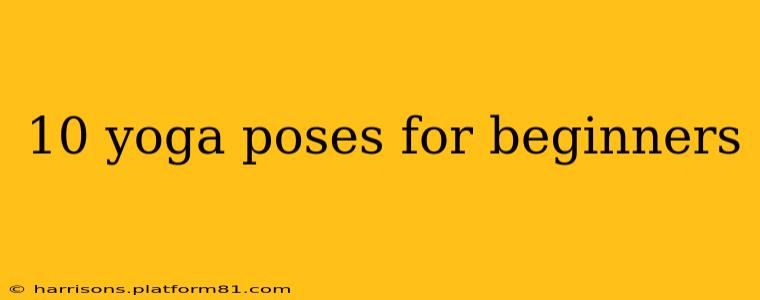Embarking on your yoga journey can feel both exciting and daunting. This guide provides ten simple yet effective yoga poses ideal for beginners, focusing on building strength, flexibility, and mindfulness. No prior experience is needed – just a comfortable space and a willingness to learn. Remember to listen to your body and modify poses as needed. Always consult your doctor before starting any new exercise program.
Mountain Pose (Tadasana)
This foundational pose sets the stage for all others. It might seem simple, but mastering Tadasana cultivates proper alignment and body awareness.
- How to: Stand with feet hip-width apart, grounding down through your feet. Lengthen your spine, relax your shoulders, and gently lengthen the crown of your head towards the ceiling. Engage your core. Notice your breath and feel your body rooted to the earth.
Downward-Facing Dog (Adho Mukha Svanasana)
A quintessential yoga pose, Downward-Facing Dog strengthens the arms, legs, and shoulders while lengthening the spine.
- How to: Start on your hands and knees. Tuck your toes and lift your hips towards the ceiling, forming an inverted V-shape. Keep your hands shoulder-width apart and feet hip-width apart. Press firmly into your palms and lengthen your spine. Pedal out your feet to release tension in your calves and hamstrings.
Child's Pose (Balasana)
This restorative pose offers a gentle stretch to the hips, thighs, and ankles while calming the nervous system.
- How to: Kneel on your mat with your knees hip-width apart and big toes touching. Sit back on your heels (as best as you can) and fold forward, resting your forehead on the mat. Extend your arms forward and relax your entire body.
Tree Pose (Vrksasana)
Tree Pose enhances balance, focus, and stability. It's a beautiful pose that cultivates grounding and mindfulness.
- How to: Stand with your feet hip-width apart. Shift your weight to your left foot, bending your right knee and placing the sole of your right foot on your inner left thigh (or ankle, if that's more comfortable). Bring your hands to your heart center or raise them overhead. Focus on a steady point in front of you to maintain balance. Repeat on the other side.
Warrior II (Virabhadrasana II)
This energizing pose strengthens legs and improves stamina while opening the hips and chest.
- How to: Start standing with your feet wide apart. Turn your right foot out 90 degrees and your left foot slightly inward. Bend your right knee, aligning it directly over your ankle. Extend your arms parallel to the floor, gazing over your right hand. Repeat on the other side.
Triangle Pose (Trikonasana)
Triangle Pose lengthens the spine, improves hip flexibility, and gently stretches the hamstrings and groin.
- How to: Begin standing with your feet wide apart. Turn your right foot out 90 degrees and your left foot slightly inward. Extend your arms to the sides, parallel to the floor. Bend at your right hip, extending your torso over your right leg. Place your right hand on your shin, ankle, or the floor, and extend your left arm towards the ceiling. Repeat on the other side.
Cobra Pose (Bhujangasana)
A gentle backbend, Cobra Pose strengthens the spine and opens the chest.
- How to: Lie on your stomach with hands under your shoulders, elbows close to your body. Press into your hands and lift your chest off the floor, keeping your shoulders relaxed and away from your ears. Gently arch your back. Look slightly upwards.
Bridge Pose (Setu Bandha Sarvangasana)
Bridge Pose strengthens the back, glutes, and hamstrings while opening the chest and shoulders.
- How to: Lie on your back with knees bent and feet flat on the floor. Press into your feet and lift your hips off the floor, creating a straight line from your shoulders to your knees. Interlace your fingers beneath your hips for support.
Seated Forward Bend (Paschimottanasana)
This forward bend stretches the hamstrings, hips, and spine, promoting relaxation.
- How to: Sit with your legs extended in front of you. Inhale and lengthen your spine. Exhale and fold forward from the hips, keeping your spine long. Reach for your toes, or as far as is comfortable, and relax your head and neck.
Savasana (Corpse Pose)
This final resting pose is crucial for integrating the benefits of your practice. It allows your body and mind to fully relax and absorb the effects of the yoga postures.
- How to: Lie on your back with arms at your sides, palms facing up. Close your eyes and allow your body to completely relax. Focus on your breath and let go of any tension you are holding.
Frequently Asked Questions (FAQs)
How often should I do yoga as a beginner?
Aim for 2-3 times a week to start, allowing your body time to adjust and recover. Consistency is key.
What should I wear to yoga?
Comfortable, breathable clothing that allows for a full range of motion is ideal.
Do I need any special equipment for beginner yoga?
A yoga mat is recommended for comfort and grip, but not strictly necessary at first.
Is yoga suitable for all fitness levels?
Yes! Yoga offers modifications for all levels, from beginners to advanced practitioners.
What are the benefits of yoga for beginners?
Yoga for beginners offers a multitude of benefits including increased flexibility, strength, balance, stress reduction, improved sleep, and enhanced body awareness.
This guide provides a solid foundation for your yoga practice. Remember to breathe deeply, listen to your body, and enjoy the journey!
